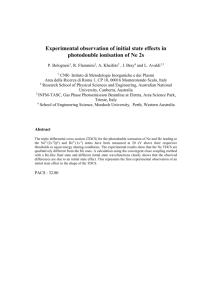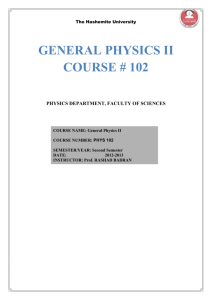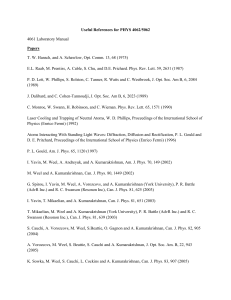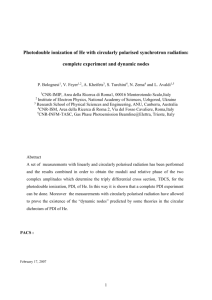BAB03 - Research School of Physics and Engineering
advertisement
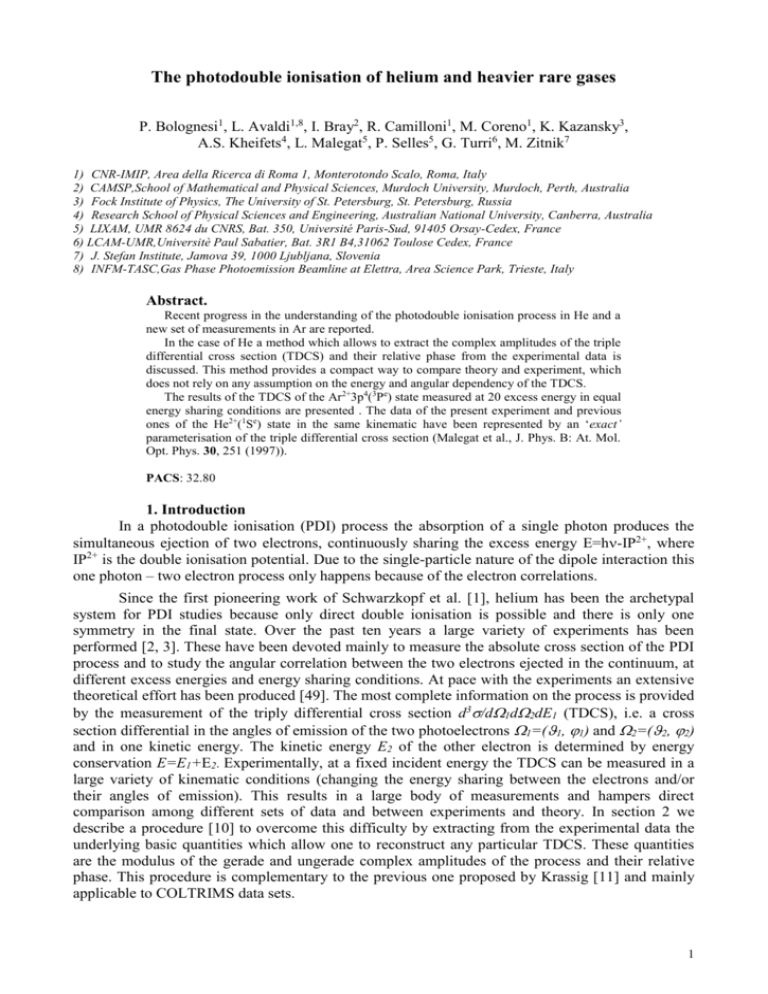
The photodouble ionisation of helium and heavier rare gases P. Bolognesi1, L. Avaldi1,8, I. Bray2, R. Camilloni1, M. Coreno1, K. Kazansky3, A.S. Kheifets4, L. Malegat5, P. Selles5, G. Turri6, M. Zitnik7 1) CNR-IMIP, Area della Ricerca di Roma 1, Monterotondo Scalo, Roma, Italy 2) CAMSP,School of Mathematical and Physical Sciences, Murdoch University, Murdoch, Perth, Australia 3) Fock Institute of Physics, The University of St. Petersburg, St. Petersburg, Russia 4) Research School of Physical Sciences and Engineering, Australian National University, Canberra, Australia 5) LIXAM, UMR 8624 du CNRS, Bat. 350, Université Paris-Sud, 91405 Orsay-Cedex, France 6) LCAM-UMR,Universitè Paul Sabatier, Bat. 3R1 B4,31062 Toulose Cedex, France 7) J. Stefan Institute, Jamova 39, 1000 Ljubljana, Slovenia 8) INFM-TASC,Gas Phase Photoemission Beamline at Elettra, Area Science Park, Trieste, Italy Abstract. Recent progress in the understanding of the photodouble ionisation process in He and a new set of measurements in Ar are reported. In the case of He a method which allows to extract the complex amplitudes of the triple differential cross section (TDCS) and their relative phase from the experimental data is discussed. This method provides a compact way to compare theory and experiment, which does not rely on any assumption on the energy and angular dependency of the TDCS. The results of the TDCS of the Ar2+3p4(3Pe) state measured at 20 excess energy in equal energy sharing conditions are presented . The data of the present experiment and previous ones of the He2+(1Se) state in the same kinematic have been represented by an ‘exact’ parameterisation of the triple differential cross section (Malegat et al., J. Phys. B: At. Mol. Opt. Phys. 30, 251 (1997)). PACS: 32.80 1. Introduction In a photodouble ionisation (PDI) process the absorption of a single photon produces the simultaneous ejection of two electrons, continuously sharing the excess energy E=h-IP2+, where IP2+ is the double ionisation potential. Due to the single-particle nature of the dipole interaction this one photon – two electron process only happens because of the electron correlations. Since the first pioneering work of Schwarzkopf et al. [1], helium has been the archetypal system for PDI studies because only direct double ionisation is possible and there is only one symmetry in the final state. Over the past ten years a large variety of experiments has been performed [2, 3]. These have been devoted mainly to measure the absolute cross section of the PDI process and to study the angular correlation between the two electrons ejected in the continuum, at different excess energies and energy sharing conditions. At pace with the experiments an extensive theoretical effort has been produced [49]. The most complete information on the process is provided by the measurement of the triply differential cross section d3/d1d2dE1 (TDCS), i.e. a cross section differential in the angles of emission of the two photoelectrons 1=(1, 1) and 2=(2, 2) and in one kinetic energy. The kinetic energy E2 of the other electron is determined by energy conservation E=E1+E2. Experimentally, at a fixed incident energy the TDCS can be measured in a large variety of kinematic conditions (changing the energy sharing between the electrons and/or their angles of emission). This results in a large body of measurements and hampers direct comparison among different sets of data and between experiments and theory. In section 2 we describe a procedure [10] to overcome this difficulty by extracting from the experimental data the underlying basic quantities which allow one to reconstruct any particular TDCS. These quantities are the modulus of the gerade and ungerade complex amplitudes of the process and their relative phase. This procedure is complementary to the previous one proposed by Krassig [11] and mainly applicable to COLTRIMS data sets. 1 The study of PDI in the rare gases heavier than He introduces two new aspects. In the heavier rare gases we have different initial and final states. Indeed, still starting from a closed shell, at the lowest double IP we ionise electrons from the p shell, while it is the s shell to be involved in He. This leads to more possible symmetries in the final state, both for the doubly charged ion and for the electron pair (see Table 1) [12,16]. Moreover, the PDI may also proceed via an indirect process. In this case the doubly charged ion is formed via the excitation and decay of a singly charged ion state embedded in the double continuum. Both aspects lead to new physics and fertile fields of investigation. In section 3 we report on the TCDS of the Ar2+3p4 (3Pe) state measured in perpendicular geometry at 20 eV excess energy and equal energy sharing condition. In contrast to the He case, there are no theoretical models published in literature to reproduce these TDCS patterns, apart from the attempt to extend the 3C model by Malcherek et al. [17, 18]. Krässig et al. [16 and ref. therein] developed a parametrisation method of the TDCS, the so–called ‘partial wave model’, where the PDI is described as a ‘shake-off’ process where the TDCS results from the product of a correlation factor, common to all the final channels, and the dipole matrix elements which account for the two possible channels p2 k1sk2p and p2 k1dk2p. In this model uncorrelated initial state wave functions were used. However, although providing a satisfactory representation of the TDCS patterns, this model raised the question of the proper interpretation of the parameters and their physical meaning. In the present work we represent our experimental results in Ar, as well as the results in He [19] measured at the same excess energy and in the same geometry, using the exact parametrisation formula of the TDCS which was introduced some years ago [20] for arbitrary target and PDI channel. This formula is here specialised to the case of the 3Pe state [21] and applied for the first time to a final state with symmetry different from the 1Se [22]. The experiments were performed using the multicoincidence end station [23] at the Gas Phase Photoemission beamline [24, 25] of the Elettra Storage ring. The description of the experimental set-up has been reported extensively elsewhere [19,23], so it will not be repeated here. 2. The extraction of the He complex amplitudes from the experimental data Considering the 1Po symmetry of the electron pair continuum wavefunction and assuming a fully linearly polarised photon beam, the He TDCS can be written as: TDCS ( Ea , Eb , ab ) ag Ea , Eb , ab cos a cos b au Ea , Eb , ab cos a cos b 2 (1) This form allows the separation of the geometric and dynamic factors. The complex amplitudes ag and au are respectively symmetric and antisymmetric with respect to the exchange of the two electrons. In practice, the only quantities of physical meaning are the squared modulus of the amplitudes and their relative phase . Independently of the particular geometry which is under consideration, it is their dependency on Ea, Eb and ab that includes all the physical information on the dynamics of the process, i.e. the effects of the electron-electron and electron-residual ion interactions. For this reason it would be interesting to have a direct comparison of the ag and au factors among different experiments and between experiments and theory, without the convolution of the kinematical terms, which may hide or emphasise possible differences. The following is a method which allows to extract the squared modulus of these amplitudes and their relative phase from three sets of internormalised data. Defining the gerade and ungerade geometrical terms i cosi1 cosi 2 (2a) i cosi1 cosi 2 (2b) and expanding the expression (1) the measured quantities can then be expressed as: 2 2 i ag i2 au i2 2 ag au cos i i 2 i 1,2,3 (3) which form a system of three equations in the three variables |ag|2, |au|2, and cos . Solving for these three quantities, ag 2 au 2 2 3 B12 B13 2 3 B12 B13 cos 1 1 3 1 B23 B21 31 B23 B21 2 2 1 2 B31B32 1 2 B31B32 3 ( 4a ) 3 (4b) 1 A23 B23 2 A31B31 3 A12 B12 1 (4c) a g au 211 A23 B23 2 2 A31B31 3 3 A12 B12 where |ag|2, |au|2, and cos are functions of the mutual angle ab and the Aij and Bij are combination of the geometrical terms Aij i j j i A ji Bij i j j i B ji (5) The uncertainties in the quantities (4a,b,c) can be calculated according to the formula for the propagation of the error [10]. The technique outlined above is applicable to all geometrical conditions where |ag| |au|0 and B12B23B31D0, where D is a compact notation for the denominator of the second fraction in equation (4c). As an example, this procedure has been applied to the He TDCS measured at 40 eV excess energy and in the two complementary kinematics of the unequal energy sharing condition with Ea/Eb=7 and 1/7 respectively [19]. These experiments are particularly suited because they include three internormalised measurements at different angles of ejection of the fixed electron, i.e. a=0, 30 and 60°. In the two complementary conditions, where Ea,Eb Eb,Ea the only difference is in the sign of cos . After checking the consistency in the |ag|2, |au|2, and cos extracted from the two complementary kinematics, we took their average in order to improve the statistics of the results. Whenever multiple determinations at the same ab were available we used their weighted average. The results obtained applying the present procedure to the experimental data are displayed in figure 1, where they are compared to the predictions of the convergent close coupling, (CCC), [6] and hyperspherical R-matrix with semiclassical outgoing wave, (HRM-SOW), [7] methods. For a better comparison of the theoretical and experimental shape, the |ag|2 has been rescaled to the mean value of the two theories at ab=135° and the same scaling factor has been applied for the |au|2. For the |ag|2 amplitude, the two theories are in agreement with each other and also with the experimental results. However, the value of the |au|2 predicted by both theories at ab=180° overestimates the experimental results. From figure 1, the experimental widths at half maximum of |ag|2 and |au|2 can be estimated to be 87 and 66° respectively, showing a faster decrease of the ungerade amplitude with respect to the gerade one. The relative phase appears to vary as a function of the relative angle ab. Even if this change is not as pronounced as in the theoretical predictions, to treat the relative phase as a constant, as done in a previous work [19] within the framework of a different parametrisation [26], is probably a too crude approximation (see horizontal band in figure 1). Having obtained these three fundamental quantities, |ag|2, |au|2, and cos , it is possible to predict the TDCS in any geometry. However, this still can not be considered a complete experiment, because we only determine the cosine of the relative phase and the sign of the phase remains undetermined. As a consequence not all the observables of the photodouble ionisation process can be determined. For example the sign of the circular dichroism in experiments with circularly polarised light is undetermined. 3 The results of figure 1 show that the proposed procedure allows to extract the squared modulus of the gerade and ungerade amplitudes of the TDCS and the cosine of their relative phase directly from the three sets of internormalised TDCS measurements. Thus the procedure provides a direct and compact way to compare theory and experiments, as well as different experiments or theories among themselves. 3. PDI studies of the Ar2+(3Pe) state measured in equal energy sharing condition In a recent work Malegat et al. [20] have derived a complete parameterisation of the angular dependence of the TDCS for photodouble ionisation valid for arbitrary target and PDI channel. Via the expansion of the correlated final state wave function on the basis of bipolar harmonics, these authors achieved the separation of the kinematic and dynamic parts of the cross section. The TDCS is parameterised in terms of the configurations of the electron pair in the continuum using a suitable set of coordinates which are easily related to the experimental set-up. This parameterisation method has been successfully applied to describe the TDCS of the He2+(1Se) and Ne2+(1Se) states measured in equal energy sharing conditions [22]. For the present studies, we specialised the general parametrisation formula to the Ar2+3p4(3Pe) final state [21]. In this case the TDCS takes the form: TDCS (3P e ) M P M D 2 (6) where MP and MD, which represent the transition amplitudes related to the configurations of the electron pair in the continuum, respectively, are given by : 3 o P and 3Do M P g K a , b g M P ab , pa , pb uK a , b u M P ab , pa , pb M D g K a , b cos 2 ab g M D ab , pa , pb uK a , b sin 2 ab u M D ab , pa , pb 2 2 The MP and MD amplitudes result from the product of kinematic terms depend on the geometry of the system g ,u K a ,b sin a sinb and dynamic terms g ,u g ,u (7) K (a ,b ) , which only (8) M P,D ( ab , pa , pb ) , which depend on the momenta pa and pb as well as the relative angle ab of the two ejected electrons and bear the information on the radial and angular correlations. These are represented via an expansion in the angular momenta of the individual electrons g ,u M P g ,u A pa , pb P101, 01 cos ab 1 (9) g ,u M D g ,u B pa , pb P122, 21 cos ab 2 where P101,01 (cos ab ) and P122, 21 (cos ab ) are the Jacobi’s polynomials. All the dynamics, i.e. the dependence of the TDCS on the particular target, initial and final state and energies, is contained in the g,u A and g,u B factors. The results of the experiments and of the fitting procedure based on formulas (6-9) are presented in figure 2 for both the He and Ar cases. Both sets have been measured in the 4 perpendicular geometry at 20 eV excess energy and equal sharing conditions. The data, measured at three different angles of the fixed electron, namely a=0,30 and 60°, are internormalised, i.e. placed on a common scale of counts. A close look to the measured TDCS reveals that there are strong differences in the number, shape and position of lobes between the He2+ and Ar2+ cases. In general these differences can be attributed to the different initial and final states or to possible two-step processes. The most striking feature is the replacement of the well known node at ab=180° in He by a lobe in Ar for the TDCS with a 0°. This is due to the dominant role taken by the favoured 3 o P symmetry [27] of the electron pair in the continuum in the case of Ar, in contrast to the unfavoured 1Po symmetry of the He case. A further difference in the TDCS of He and Ar at a=0° consists in two lobes observed at b18025° in the Ar TDCS pattern. These structures, unexplained in the representation with formulas (6-9), may be attributed to the presence of an indirect process that involves the excitation and decay of an Ar+* state. Although exact from the formal point of view, the infinite expansions in partial waves of formulas (9) have to be truncated at the time of their implementation in a fitting procedure. According to the results of a study of the 2 as a function of the max in the expansion in partial waves of formulas (9), we decided to truncate the expansion to max=5. Furthermore, we observed that the 3Po wave contribution of the TDCS on its own already contains all the main features to describe the measured Ar TDCS. Adding the contribution of the 3Do wave does not improve neither the 2 value nor the shape of the curve. Thus we have ‘neglected’ this contribution. On one hand this finding is in agreement with the observations of Waymel et al [12]. These authors measured the TDCS of the Kr2+(3Pe) state, in coplanar geometry, equal energy sharing, a=90° and using the unpolarised light provided by a He II lamp. They observed ‘an excellent agreement with the experiment obtained with the 3Po alone’. On the other hand, theoretical calculations performed for the case of the Kr atom based on the eikonal wave and R-matrix, (EWRM), method [28] predicts the 3Po and 3Do waves to contribute to the TDCS in different angular domains. Interference between the two waves were expected to produce ‘spectacular’ effects, especially in perpendicular geometry. The results of the fitting procedures are in a fairly good agreement with the experimental results, at least as far as the main featuresof the TDCS are concerned. The values of the modulus and phase of the complex amplitudes in formulas (9), used as fitting parameters of this representation, are reported in figure 3. It is important to emphasise that, for a fixed energy condition, the g A parameters do not depend on the particular geometry of the experiment. This entitled us to perform a global fitting, where the three sets of data corresponding to a=0, 30 and 60 ° are fitted simultaneously and share the same parameters. This was found to be very useful to improve the ratio between number of experimental points and number of fitting parameters. Moreover the different geometries are sampling different regions of the multidimensional space of the parameters. Therefore this is very useful to reduce the possibility to end up with a spurious solution. From figure 3, it appears that the modulus of the g A parameters of He is systematically decreasing as increases. For the Ar case, on the other hand, there is a clear indication that the modulus of the g A parameters has a maximum at = 3, with a rapid drop at =4. max identifies the most excited configuration max(max-1) of the escaping electron pair and provides a measure of the strenght of the angular correlation [22]. Thus this finding suggests that the two electrons ejected from the 3p orbital of Ar display a stronger angular correlation than the pair ejected from the 1s orbital of He. It could be argued that the 3p electrons in Ar are better shielded from the nucleus, so that they are more strongly correlated with respect to the He case [29]. 4. Conclusions The last ten years have seen a large effort to unravel the process of PDI in He. A large body of experimental results and several theoretical methods has been produced so far. However, a direct 5 comparison between theory and experiments, and among different experiments is not always a simple task. The different facets of PDI in He can be explored by changing one or more experimental parameters. However the basic quantities which are relevant to the description of the process are only three, the square modulus of the complex gerade and ungerade amplitudes and the cosine of their relative phase. We have proposed a procedure which allows to extract these quantities directly from the experimental data and applied it to a set of He TDCS measurements in unequal energy sharing conditions and complementary kinematics. Hopefully this procedure will greatly simplify the comparison between experiments and theories. A further step in the understanding of PDI involves the study of the process in the heavier rare gases. So far some experiments [12-16] have been performed, but, to our knowledge, no theory have been developed yet. We have investigated the PDI of the Ar2+(3Pe) state in a variety of energy and geometrical conditions [21], and reported here the results of the measurements in equal energy sharing condition at 20 eV excess energy. The data have been described using a general parameterisation method[20], based on the expansion in partial waves of the amplitudes. The results have shown that the TDCS seems to be dominated by the contribution of the 3Po wave. Whether this result is accidental, because of the energy dependency of the M P M D ratio, or of the particular representation or of the early truncation of the infinite expansion in (9) is still an open question. A more systematic investigation is needed either to confirm or to disprove this finding. The use of the parameterisation formulas (6-9) provides useful information on the elementary constituents of the TDCS, for example the dependence on of the amplitudes in the expansion in partial waves of the MP and MD matrix elements. Finally the investigation of PDI in the heavier rare gases would greatly benefit from the development of ab-initio theoretical models, whose application is not limited to He. 6 A2+ electronic configuration ns2np4 ns1np5 ns0np6 Ion state symmetry 3 e P 1 e D 1 e S 1 o P 1 e S Electron pair symmetry 3 o 3 o P, D 1 o 1 o 1 o P ,D, F 1 o P 1 e 1 e S, D 1 o P Table 1 80 3 CCC HRM-SOW exp |au| (barn/ eVsr ) 2 2 2 |ag| (barn/ eVsr ) 60 1 2 2 40 20 0 0 60 90 120 150 180 ab (degree) 60 90 120 150 180 ab (degree) cos() 0.0 -0.5 -1.0 -1.5 60 90 120 150 180 ab(degree) Figure 1. ag2, au2 and the cosine of their relative phase, , versus the relative angle ab obtained from the average of the two experimental TDCS at E=40 eV, Ea=35 eV and Eb=5 eV and Ea=5 eV and Eb=35 eV. The experimental results are compared with the predictions of the CCC (full line)[6] and HRM-SOW (dash line)[7] theories.The stripe shows the constant value used in a previous work [19] in the framework of a different parametrisation of the TDCS[26]. 7 90 90 160 120 60 90 360 120 coincidence yield (arb. units) 120 60 30 150 80 He2+(1Se) 720 60 30 150 180 30 150 360 ea 0 180 80 0 0 330 210 240 180 180 0 330 210 300 240 160 0 180 360 0 330 210 300 360 270 240 300 720 270 270 90 90 120 60 180 0 0 250 175 330 210 240 30 180 0 330 210 0 550 Ar2+(3Pe) 30 180 0 330 210 300 240 500 350 60 150 550 240 300 120 150 250 30 1100 60 300 1100 270 270 270 Figure 2. The TDCS of the He2+1s(1Se) and Ar2+3p4(3Pe) states measured 20 eV above their respective double IP, in equal energy sharing condition, perpendicular geometry and three different directions of ejection of the fixed electron, 0, 30 and 60° (dots) with respect to the polarisation axis of the photon beam. The solid line represent the global fit obtained from the parameterisation formulas (6-9), truncated at max=5. 180 80 He 60 120 cos coincidence yield (arb. units) 0 120 150 175 90 500 350 g Al 40 Ar 20 60 0 0 1 2 3 l 4 5 1 2 3 4 5 l Figure 3. The fitting parameters, gA and their relative phases obtained using the parameterisation formulas for the He2+(1Se) and Ar2+(3Pe) TDCS (see figure 2) measured at 20 eV excess energy and equal energy sharing conditions. The expansion in partial waves in formula (9) has been truncated at max=5 and only the gMP contribution to the TDCS has been included. 8 References 1. Schwarzkopf, O., Krassig, B., Elmiger, J. and Schmidt, V., Phys Rev. Lett. 70, 3008 (1993). 2. King, G.C. and Avaldi L., J. Phys. B: At. Mol. Opt. Phys. 33, R215 (2000). 3. Briggs, J.S. and Schmidt, V., J. Phys. B: At. Mol. Opt. Phys. 33, R1 (2000). 4. Maulbetsch, F. and Briggs, J. S., J. Phys. B: At. Mol. Opt. Phys. 27, 4095 (1994). 5. Pont, M. and Shakeshaft, R., J. Phys. B: At. Mol. Opt. Phys. 28, L571 (1995). 6. Kheifets, A. S. and Bray, I., J. Phys. B: At. Mol. Opt. Phys. 31, L447 (1998); Phys. Rev. Lett. 81, 4588 (1998). 7. Malegat, L., Selles, P. and Kazansky, A., Phys. Rev. Lett. 85, 4450 (2000) ; Selles, P., Malegat, L. and Kazansky, A. K., Phys. Rev. A65, 032711 (2002). 8. Pindzola, M. S. and Robicheaux, F., Phys. Rev. A57, 318 (1998). 9. Rescigno, T. N., Baertschy, M., Isaacs, W. A. and McCurdy, C. W., Science 286, 2474 (1999). 10. Bolognesi, P., Kheifets, A.S., Bray, I., Malegat, L., Selles, P., Kazansky, A. K. and Avaldi, L., J. Phys. B: At. Mol. Opt. Phys. 36, L241 (2003). 11. Krässig, B., ‘Correlations, polarisation and ionisation in atomic systems’, AIP Conf. Proc. 604, Madison D.H. and Schulz M. Ed.s, Rolla (USA), p.12 (2001). 12. Waymel, D., Andric, L., Mazeau, J., Selles, P. and Huetz, A., J. Phys. B: At. Mol. Opt. Phys. 26, L123 (1993). 13. Krässig, B., Schwarzkopf, O. and Schmidt, V., J. Phys. B: At. Mol. Opt. Phys. 26, 2589 (1993). 14. Schaphorst, S.J., Krässig, B, Schwarzkopf, O., Scherer, N. and Schmidt, V., J. Phys. B: At. Mol. Opt. Phys. 28, L233 (1995). 15. Schaphorst, S.J., Krässig, B., Schwarzkopf, O., Scherer, N., Schmidt, V., Lablanquie, P., Andric, L., Mazeau, J. and Huetz, A., J. Electron Spectrosc. Relat. Phenom. 76, 229 (1999). 16. Krässig, B., Schaphorst, S.J., Schwarzkopf, O., Scherer, N., Schmidt, V., J. Phys. B: At. Mol. Opt. Phys. 29, 4255 (1996). 17. Malcherek, A.W., Maulbetsch, F. and Briggs, J.S., J. Phys. B: At. Mol. Opt. Phys. 29, 4127 (1996). 18. Bolognesi, P., King, G.C. and Avaldi, L. submitted to Radiation Physics and Chemistry (2003) 19. Bolognesi, P., Camilloni, R., Coreno, M., Turri, G., Berakdar, J., Kheifets, A.S. and Avaldi, L., J. Phys. B: At. Mol. Opt. Phys. 34, 3193 (2001). 20. Malegat, L., Selles, P. and Huetz, A., J. Phys. B: At. Mol. Opt. Phys. 30, 251 (1997); J. Phys. B: At. Mol. Opt. Phys. 35, 5169 (2002). 21. Bolognesi, P., Zitnik, M., Turri, G., Coreno, M., Camilloni, R., Malegat, L., Selles, P. and L. Avaldi, submitted to J. Phys. B: At. Mol. Opt. Phys. (2003). 22. Malegat, L., Selles, P., Lablanquie, P., Mazeau, J. and Huetz, A., J. Phys. B: At. Mol. Opt. Phys. 30, 263 (1997). 23. Blyth, R.R., Delaunay, R., Zitnik, M., Krempasky, J., Krempaska, R., Slezak, J., Prince, K.C., Richter, R., Vondracek, M., Camilloni, R., Avaldi, L., Coreno, M., Stefani, G., Furlani, C., DeSimone, M., Stranges, S. and Adam M.-Y., J. Electron Spectrosc. Relat. Phenom. 101-103, 959 (1999). 24. Diviacco, B., Bracco, R., Poloni, C., Walker, R.P. and Zangardo, D., Rev. Sci. Instrum. 63, 388 (1992). 25. Melpignano, P., Di Fonzo, S., Bianco, A. and Jark, W., Rev. Sci. Instrum. 66, 2125 (1995). 26. Cvejanovic, S. and Reddish, T. J., J. Phys. B: At. Mol. Opt. Phys. 33, 4691 (2000) 27. Greene, C.H. and Rau, A.R.P., Phys. Rev. Lett. 48, 533 (1982); J. Phys. B: At. Mol. Opt. Phys. 16, 99 (1983). 28. Kazansky, A. K. and Ostrovsky, V. N., Phys Rev A. 51, 3712 (1995); Kazansky, A. K. and Ostrovsky, V. N., J. Phys. B: At. Mol. Opt. Phys. 28, L333 (1995); Kazansky, A. K. and Ostrovsky, V. N., Phys Rev A. 52, 1775 (1995). 9 29. Beyer, H.-J., West, J.B., Ross, K.J. and De Fanis, A., J. Phys. B: At. Mol. Opt. Phys. 33, L767 (2000). 10


